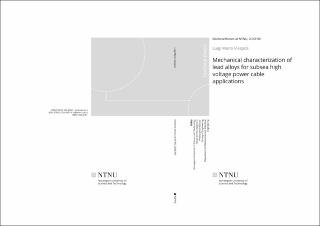| dc.contributor.advisor | Berto, Filippo | |
| dc.contributor.author | Viespoli, Luigi Mario | |
| dc.date.accessioned | 2020-09-25T09:16:39Z | |
| dc.date.available | 2020-09-25T09:16:39Z | |
| dc.date.issued | 2020 | |
| dc.identifier.isbn | 978-82-326-4951-8 | |
| dc.identifier.issn | 1503-8181 | |
| dc.identifier.uri | https://hdl.handle.net/11250/2679635 | |
| dc.description.abstract | Subsea power cables are an important component in electrical grids, connecting both offshore facilities to the mainland and interconnecting countries through sea stretches, for lengths up to hundreds of kilometres. Such cables ideally consist of three components: the conductor, copper or aluminium, the insulation, mass impregnated oil-paper or crosslinked polyethylene and the armouring, to withstand axial and radial loads. Cables for the use with voltages in excess of 52 kV require a sheathing layer of a stable, watertight material, to prevent electrical failure of the powerline due to water penetration through the polymer layers. The materials universally adopted for this purpose are lead alloys, due to their great chemical stability, ductility and ability to be continuously extruded for great lengths.
The low melting point of lead, together with low self-diffusion activation energy and vacancy formation enthalpy make so that these alloys are affected by time dependent deformation, or creep, even at room temperature. It would certainly be of great advantage for the industry and the environment to gain a deeper understanding of the damage mechanics of these alloys, in particular the interaction between creep and fatigue phenomena, in order to acquire the necessary tools for a conscious estimate of their structural integrity, in contrast to what has been done traditionally. That is relying on experience and previous designs rather than scientific knowledge, thus leading to potentially overconservative designs naturally affected by excessive use of a potentially hazardous material with a consequent economic and environmental negative impact. The purpose of this thesis is to investigate the mechanical properties of a lead alloy commercially used for producing submarine power cable sheathing with a goal focused approach based on the special necessities of this industry. The work performed, here summarized in the form of the papers appended, consists in the study of the tensile properties at different strain rate with the influence of microstructure, the fatigue performance of full-scale cables and small scale specimens cut out from the component together with in situ observations of the monotonic and cyclic deformation behaviour, focused on the qualitative observation of the mechanisms causing deformation and damage. Due to the high ductility of the material tested, numerous practical challenges have arisen and the digital image correlation has been a fundamental tool for computing the strain experienced by the material. The results have been used for the calibration of material models able to account for the time dependent deformation behaviour and used for the full scale modelling of the component with the goal of connecting some of the design parameters with the stress state of the sheathing and, consequentially, with the full scale fatigue performance. | en_US |
| dc.language.iso | eng | en_US |
| dc.publisher | NTNU | en_US |
| dc.relation.ispartofseries | Doctoral theses at NTNU;2020:301 | |
| dc.relation.haspart | Paper 1:
Viespoli, Luigi Mario; Johanson, Audun; Alvaro, Antonio; Nyhus, Bård; Sommacal, Alberto; Berto, Filippo.
Tensile characterization of a lead alloy: creep induced strain rate sensitivity. Materials Science & Engineering: A 2019 ;Volum 744. s. 365-375 | |
| dc.relation.haspart | Paper 2:
Viespoli, Luigi Mario; Johanson, Audun; Alvaro, Antonio; Nyhus, Bård; Berto, Filippo.
Room temperature creep mechanism of a Pb-Sn-Sb lead alloy. Procedia Structural Integrity 2019 ;Volum 18. s. 86-92
https://doi.org/10.1016/j.prostr.2019.08.142
Attribution-NonCommercial-NoDerivatives 4.0 International (CC BY-NC-ND 4.0) | |
| dc.relation.haspart | Paper 3:
Viespoli, Luigi Mario; Johanson, Audun; Alvaro, Antonio; Nyhus, Bård;
Subsea power cable sheathing: an investigation of lead fatigue performance | |
| dc.relation.haspart | Paper 4: Berto, Filippo.
Wan, Di; Viespoli, Luigi Mario; Johanson, Audun; Hagen, Anette Brocks; Berto, Filippo; Alvaro, Antonio.
Tensile and fatigue behavior of a Pb-Sn-Sb alloy investigated via smallscale in-situ mechanical testing in SEM | |
| dc.relation.haspart | Paper 5:
Johanson, Audun; Viespoli, Luigi Mario; Alvaro, Antonio; Berto, Filippo.
Small and Full-Scale Fatigue Testing of Lead Cable Sheathing. ISOPE - International Offshore and Polar Engineering Conference. Proceedings 2019 s. 1922-1927 | |
| dc.relation.haspart | Paper 6:
Viespoli, Luigi Mario; Johanson, Audun; Alvaro, Antonio; Nyhus, Bård; Berto, Filippo.
Strain controlled medium cycle fatigue of a notched Pb-Sn-Cd lead alloy. Engineering Failure Analysis 2019 ;Volum 104. s. 96-104
https://doi.org/10.1016/j.engfailanal.2019.05.018 | |
| dc.relation.haspart | Paper 7:
Johanson, Audun; Viespoli, Luigi Mario; Nyhus, Bård; Alvaro, Antonio; Berto, Filippo.
Experimental and numerical investigation of strain distribution of notched lead fatigue test specimen. MATEC Web of Conferences 2018 ;Volum 165:05003. s. 1-6
https://doi.org/10.1051/matecconf/201816505003
This is an Open Access article distributed under the terms of the Creative Commons Attribution License 4.0 (CC BY 4.0) | |
| dc.relation.haspart | Paper 8:
Viespoli, Luigi Mario; Panza, Luigi; Johanson, Audun; Alvaro, Antonio; Soma, Aurelio; Berto,Filippo.
Tape winding angle influence on subsea cable sheathing fatigue performance | |
| dc.title | Mechanical characterization of lead alloys for subsea high voltage power cable applications | en_US |
| dc.type | Doctoral thesis | en_US |
| dc.subject.nsi | VDP::Technology: 500::Mechanical engineering: 570::Machine construction and engineering technology: 571 | en_US |
